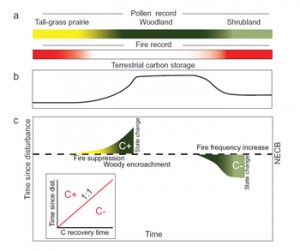 Publications abound in the Battles lab this fall! Here are some recent research papers from graduate students:
Publications abound in the Battles lab this fall! Here are some recent research papers from graduate students:
- From a diverse research team including Carrie Levine, this new paper evaluates uncertainty in hydrologic export of solutes in three watersheds: in the Northeast and Southeast US and in the Gomadansan Experimental Forest, Japan. Read Article
- Natalie van Doorn’s recent participation in a research team examining environmental chemistry using Scots pine has yielded two publications. The first, in Science of Total Environment, examines bioaccumulation of heavy metals from mine soils. The second, in New Forests, uses Scots pine growth to assess productivity of reclaimed forest sites.
Read Article in Science of Total Environment
Read Article in New Forests
- And in new paper Simon Dufour, Maya Hayden and their collaborators ask, “Do abandoned channels host different plant species compared with the surrounding floodplain?” The study, now out in Ecohydrology, investigates vegetation community and disturbance dynamics along riparian forest gradients. Read Article

 At the annual symposium of the California Invasive Plant Council in Chico, Joan Dudney presented her research on the lagged effects of rainfall on rangeland plant community composition. Results suggest that native plants may fare better in grazed grasslands under increasing drought conditions, but forage production is apt to suffer. Joan also earned an award for her talk – congrats to Joan!
At the annual symposium of the California Invasive Plant Council in Chico, Joan Dudney presented her research on the lagged effects of rainfall on rangeland plant community composition. Results suggest that native plants may fare better in grazed grasslands under increasing drought conditions, but forage production is apt to suffer. Joan also earned an award for her talk – congrats to Joan!





 A big “Thank you!” goes out to our summer research assistants, Natalie Holt and Alex Javier.
A big “Thank you!” goes out to our summer research assistants, Natalie Holt and Alex Javier.  From May through August Natalie and Alex lent their talents to our research crew, completing lab projects throughout the Sierra Nevada at Baker Forest, Blodgett Forest Research Station, and in Sequoia National Park. Leading the work were Carrie Levine, Flora Krivak-Tetley, and Stella Cousins. Joe Battles was also a big help during our studies at Blodgett.
From May through August Natalie and Alex lent their talents to our research crew, completing lab projects throughout the Sierra Nevada at Baker Forest, Blodgett Forest Research Station, and in Sequoia National Park. Leading the work were Carrie Levine, Flora Krivak-Tetley, and Stella Cousins. Joe Battles was also a big help during our studies at Blodgett.  Together we measured thousands of trees, mapped forest plots, built snazzy seed traps, dissected snags, compared swimming holes, and much, much, more. Thanks to everyone involved for the hard work! This summer’s efforts are sure to keep us busy for months (years?) to come.
Together we measured thousands of trees, mapped forest plots, built snazzy seed traps, dissected snags, compared swimming holes, and much, much, more. Thanks to everyone involved for the hard work! This summer’s efforts are sure to keep us busy for months (years?) to come.